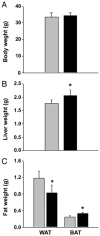Bone is a target for the antidiabetic compound rosiglitazone
- PMID: 14500573
- PMCID: PMC1855213
- DOI: 10.1210/en.2003-0746
Bone is a target for the antidiabetic compound rosiglitazone
Abstract
Rosiglitazone is an FDA-approved oral antidiabetic agent for the treatment of type 2 diabetes. This compound improves insulin sensitivity through the activation of the nuclear receptor, peroxisome proliferator-activated receptor-gamma (PPAR-gamma). In addition to sensitizing cells to insulin, the PPAR-gamma2 isoform appears to be critical for the regulation of osteoblast and adipocyte differentiation from common mesenchymal bone marrow progenitors. We have demonstrated previously that PPAR-gamma2 activated with rosiglitazone acts as a dominant inhibitor of osteoblastogenesis in murine bone marrow in vitro. Here, we show that in vivo, rosiglitazone administration results in significant bone loss. When rosiglitazone (20 microg/g body weight/d) was given to 6-month-old, nondiabetic C57BL/6 mice for 7 wk, a significant decrease in total body bone mineral density was observed. Analysis of bone microarchitecture, using micro-computed tomography, demonstrated a decrease in bone volume, trabecular width, and trabecular number and an increase in trabecular spacing. Histomorphometric analysis showed a decrease in bone formation rate, with a simultaneous increase in fat content in the bone marrow. Changes in bone morphology and structure were accompanied by changes in the expression of osteoblast- and adipocyte-specific marker genes; the expression of the osteoblast-specific genes Runx2/Cbfa1, Dlx5, and alpha1(I)collagen were decreased, whereas the expression of the adipocyte-specific fatty acid binding protein aP2, was increased. These in vivo data suggest that rosiglitazone therapy may pose a significant risk of adverse skeletal effects in humans.
Figures





References
-
- Werner AL, Travaglini MT. A review of rosiglitazone in type 2 diabetes mellitus. Pharmacotherapy. 2001;21:1082–1099. - PubMed
-
- Henney JE. From the Food and Drug Administration. JAMA. 1999;282:932. - PubMed
-
- Girnun GD, Spiegelman BM. PPAR-γ ligands: taking part in chemo-prevention. Gastroenterology. 2003;124:564 –567. - PubMed
Publication types
MeSH terms
Substances
Grants and funding
LinkOut - more resources
Full Text Sources
Other Literature Sources
Medical
Research Materials

